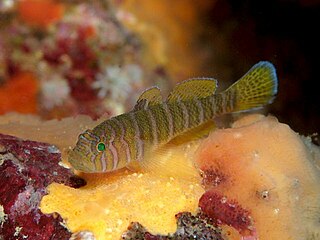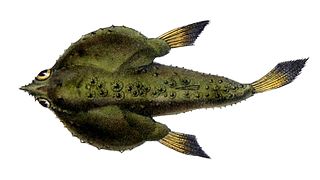
The blackspot shark is a small species of requiem shark in the family Carcharhinidae found in the tropical Indo-West Pacific Ocean between latitudes 24°N and 30°S, from the surface to a depth around 40 m (130 ft). Its length is a little under one meter (yard) and it is not considered to be dangerous to humans. It feeds mainly on fish, crustaceans, and squid. This shark is also caught in small-scale fisheries for human consumption.

Acentrogobius is a genus of gobies native to marine, fresh and brackish waters of the coasts of the Indian Ocean and the western Pacific Ocean.
Priolepis robinsi is a species of goby native to the Atlantic Ocean off of Santa Marta, Colombia. The specific name honours the American ichthyologist C. Richard Robins who was at the University of Miami where he studies neotropical gobies.
Sicyopterus lagocephalus, the red-tailed goby or blue stream goby, is a species of goby native to islands of the Indian Ocean from the Comoros to the Mascarene Islands to the Pacific Ocean where it reaches French Polynesia and can be found as far north as Japan. It is an amphidromous species: adults can be found in swift-flowing streams with rocky beds but the eggs hatch at sea and the larval stage remains in marine waters, migrating to freshwaters when they reach the postlarval stage. This species can reach a total length of 13 cm (5 in). In some places it is an important species for local consumption with the post-larvae being caught as they mass in estuaries.

Glossogobius giuris, the tank goby, is a species of goby native to fresh, marine and brackish waters from the Red Sea and East Africa through South Asia and the Indian Ocean to China, Australia and the islands of the Pacific Ocean. This species can also be found in the aquarium trade. It is also known as the bar-eyed goby, flat-headed goby and the Gangetic tank goby.

Acanthurus olivaceus, also known as the orange-band surgeonfish, the orange-shoulder surgeonfish or the orangebar tang, is a member of the family Acanthuridae, the surgeonfishes. It lives in the tropical waters of the Indo-west Pacific.

Priolepis nocturna, the Blackbarred reefgoby, is a species of goby native to the Indian Ocean and the western Pacific Ocean where it occurs at depths of from 8 to 30 metres on coral reefs. It inhabits crevices in the reef. This species can reach a length of 3.9 centimetres (1.5 in) SL.

Acanthurus guttatus is a marine reef tang in the fish family Acanthuridae. It is found in shallow waters on reefs in the Indo-Pacific.

Oxyurichthys microlepis, the maned goby, is a species of goby native to tropical marine and brackish waters along the coasts of the Indian Ocean from Africa to the western Pacific Ocean where it occurs in estuaries and inshore waters to depths of about 75 metres (246 ft). It occurs in the Mekong Delta and is suspected to use the tidal flow up the river to reach as far inland as Cambodia. This species can reach a length of 13.5 centimetres (5.3 in) TL. It is of minor importance to local commercial fisheries and can also be found in the aquarium trade.

Cryptocentrus also known as Watchman gobies, and one of the genera known as shrimp gobies or prawn gobies, is a genus of gobies native to tropical marine waters of the Indian and Pacific oceans.

Oplopomus oplopomus, commonly known as the spinecheek goby, is a species of goby native to the Indo-Pacific region. They can grow to a maximum length of 10 centimetres (3.9 in). They inhabit coral reefs.

Oplopomus is a genus of gobies found in coral reefs of the Indo-Pacific region. It contains two species.
Trypauchen vagina, commonly known as the burrowing goby, is a species of eel goby found in the Indo-Pacific region. It has an elongated body about 20 to 22 cm in length. It is reddish-pink in color and possesses distinctive pouches in the upper edges of its gill covers. It lives in burrows in the silty and muddy bottoms of its marine and brackish habitats. It has reduced eyes that are entirely covered with skin and the anterior portion of its head is protected by thick flesh. Both adaptations aid it in digging its burrows.

The slender grouper is a species of marine ray-finned fish, a grouper from the subfamily Epinephelinae which is part of the family Serranidae, which also includes the anthias and sea basses. It is the only species in the genus Anyperodon. It is found in the Indo-Pacific region.

Valenciennea helsdingenii is a species of goby from the Indo-Pacific. It is commonly known as the twostripe goby, black-lined sleeper goby, or railway sleeper goby. It can grow up to a length of 25 cm (9.8 in) and is distinguishable by two prominent orange to black lines running longitudinally through its body.

Priolepis cincta, commonly known as the girdled goby, is a species of goby fish described by Regan in 1908.

Ogcocephalus notatus, the oval batfish, is a species of batfish in the family Ogcocephalidae. It is found in the tropical western Atlantic Ocean.

Liza carinata, the keeled mullet, is a species of grey mullet from the family Mugilidae which is found in the western Indian Ocean and eastern Mediterraean Sea. It colonised the Mediterranean by Lessepsian migration from the Red Sea through the Suez Canal. The keeled mullet is a species of minor importance in commercial fisheries.
Selenanthias myersi is a species of fish in the family Serranidae, a family that includes the sea basses, the groupers and fairy basslets. It is native to the tropical western and central Pacific Ocean.
















